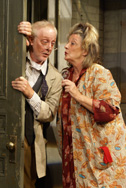I was checking my e-mail yesterday afternoon when I got this message from a friend of mine who had just returned to his home in North Carolina from a visit to New York:
Just back. Thank God I wasn’t going to Charlotte. That plane left
just a little over an hour after ours.
“What plane?” I said out loud, and immediately went surfing for news. I didn’t have to go far to find out about the bird strike that brought down a commercial airliner that had just taken off from LaGuardia, the airport from which I depart once or twice a month.
Being a drama critic, the next thing I thought of was Charlie Victor Romeo, the extraordinary documentary play whose script is drawn from black-box recordings:
I reviewed Charlie Victor Romeo (in which a bird strike figures prominently) five years ago in The Wall Street Journal. What I wrote then seems worth reprinting now as we read of how the captain and crew of US Airways 1549 saved the lives of 155 men, women, and children. The word hero gets tossed about too casually nowadays, but sometimes it’s exactly right.
* * *
Forget reality TV. If you want to watch raw slices of real life–and death–transformed into the highest possible drama, go see “Charlie Victor Romeo,” a performance piece based on transcripts of the black-box recordings of six airplane crashes. (The title is military alphabetic code for “Cockpit Voice Recorder.”) “Charlie Victor Romeo” holds you in a hammerlock for 90 unforgettable minutes. It’s the most frightening show I’ve ever seen….
“Charlie Victor Romeo” was created by Bob Berger, Patrick Daniels and Irving Gregory of Collective: Unconscious, a Manhattan-based experimental theater group. It’s a low-budget, unabashedly unglamorous affair. You stroll into a grubby black-box theater (talk about ironic!) in which a nondescript mock cockpit is placed at center stage. The house goes dark and a slide flashes on a screen overhead, telling you the flight number and date and how many people were on board, followed by a stark description of what went wrong: ICING. EXPLODING ENGINE. MULTIPLE BIRD STRIKES. Then the lights come up and all hell breaks loose.
Not always at once, though. Instead, you might find a pilot and co-pilot chatting away agreeably, flirting with a flight attendant, griping about this or that minor nuisance. But sooner or later–always without warning–something terrible happens, and in an instant the theater becomes a sweatbox. You watch in horror as the crew scrambles to save the ship while alarms beep and buzz, the radio crackles urgently and passengers scream on the far side of the cockpit door. Sometimes the crisis is protracted, sometimes shockingly brief (one flight lasts for just a minute and a half). Then the theater is filled with the clamor of a crash landing, abruptly cut off by a sharp click as the house goes black. After a seemingly endless pause, the slide shown at the beginning of the flight is flashed on the screen again, this time with an additional line at the bottom: NO SURVIVORS. NO SURVIVORS. 4 SURVIVORS. NO SURVIVORS.
If any of this sounds gimmicky–or, worse yet, exploitative–be assured that “Charlie Victor Romeo” is deadly serious from takeoff to landing. The transcripts have not been altered in any way. We learn nothing personal about the men and women who are fighting for their lives, not even their names. All we see is what happens when they are plunged into chaos. Once or twice they panic. (In one hair-raising sequence, the pilot and co-pilot quarrel furiously over what to do next.) More often, though, they conduct themselves coolly, even heroically. And though the clipped dialogue is as unpretentious as a conversation overheard on a crosstown bus, it’s full of lines that stick in your head like bloody thorns: “I’ll tell you, flying at night, I don’t like it worth a —-.” “We have no basic instruments, no altimeter, no airspeed indicator. We declare an emergency!” “I really have my doubts you’ll see us standing up, honey.” “Whatever you do, keep us away from the city.” Click.
Mr. Gregory’s cut-to-the-crash direction and the unselfconscious performances of the eight-person cast are as good as they could possibly be. Likewise the thunderous, enveloping sound effects created by Jamie Mereness, which are central to the overwhelming impact of “Charlie Victor Romeo.” I can’t think of a better tribute to its plain-spoken realism than the fact that an earlier production was filmed by the U.S. Air Force and is now being used as a training video. One of the pilots portrayed on stage, it seems, actually attended a performance–and was impressed.
I have a special perspective on “Charlie Victor Romeo”: I became afraid of flying a few years ago, and went into psychotherapy in order to cope with the problem. Not surprisingly, I found the first part of the show so alarming that I wanted to hide under my seat. But as I watched each flight unfold, I found myself drawn ever more deeply into the drama of brave men and women doing their best to buck the odds. Sometimes they did, more often not. Yet at evening’s end I felt oddly reassured by the knowledge of how hard they had tried. So will you.

 •
•